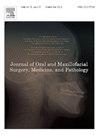Investigation of periodontal tissue regeneration using octacalcium phosphate and collagen composite
IF 0.4
Q4 DENTISTRY, ORAL SURGERY & MEDICINE
Journal of Oral and Maxillofacial Surgery Medicine and Pathology
Pub Date : 2024-08-16
DOI:10.1016/j.ajoms.2024.08.009
引用次数: 0
Abstract
Objective
This study aimed to investigate periodontal tissue regenerative potential of octacalcium phosphate (OCP) and collagen composite (OCPcol), recognized as excellent bone-regenerative materials, in artificial bone defect models using beagle dogs. This study specifically assessed the efficacy of OCPcol in periodontal soft-tissue regeneration.
Methods
OCPcol was implanted in bone defects adjacent to the roots of the left mandibular third and fourth premolars in six beagle dogs (OCP group), while five dogs did not receive OCPcol (control group). The dogs were observed for 3 months. The specimens were evaluated radiologically and histologically.
Results
Microcomputed tomography revealed bone regeneration originating from the lateral cortical bone surface adjacent to the created defect. The superficial layer of the regenerated bone was cortical bone-like and continuous with the upper and lower alveolar bone. The bone was regenerated by maintaining a continuous void in the periodontal ligament space above and below the dentinal defect. Dental defects of roots were not regenerated. The control group did not exhibit sufficient bone regeneration. Histologically, in the OCP group, formation of new cementum was observed on the outer surface of the root dentin, with connective tissue attachment and an oblique-running periodontal ligament in the space between the new bone and dentin. However, the dentinal defects were not regenerated.
Conclusions
Alveolar bone and periodontal ligament regenerated when OCPcol was implanted into a bone and dentinal defect created around a natural tooth root. These results suggest that OCPcol effectively regenerates periodontal tissue, without ankylosis.
使用磷酸八钙和胶原蛋白复合材料进行牙周组织再生的研究
目的 本研究旨在使用小猎犬在人工骨缺损模型中研究磷酸八钙(OCP)和胶原复合材料(OCPcol)的牙周组织再生潜力。本研究特别评估了 OCPcol 在牙周软组织再生中的功效。方法将 OCPcol 植入六只小猎犬(OCP 组)左下颌第三和第四前臼齿根部附近的骨缺损处,而五只小猎犬未接受 OCPcol(对照组)。对这些狗进行了为期 3 个月的观察。结果 微计算机断层扫描显示,骨再生源于邻近缺损处的外侧皮质骨表面。再生骨的表层呈皮质骨样,与上下牙槽骨连续。通过在牙本质缺损上下的牙周韧带间隙中保持连续的空隙,实现了牙槽骨的再生。牙根缺损没有再生。对照组没有表现出足够的骨再生。从组织学角度看,OCP 组观察到牙根牙本质外表面形成了新的骨水泥,新骨和牙本质之间的空隙中有结缔组织附着和斜行牙周韧带。结论 将 OCPcol 植入天然牙根周围的牙槽骨和牙本质缺损处后,牙槽骨和牙周韧带得以再生。这些结果表明,OCPcol 能有效地使牙周组织再生,而不会发生强直。
本文章由计算机程序翻译,如有差异,请以英文原文为准。
求助全文
约1分钟内获得全文
求助全文
来源期刊

Journal of Oral and Maxillofacial Surgery Medicine and Pathology
DENTISTRY, ORAL SURGERY & MEDICINE-
CiteScore
0.80
自引率
0.00%
发文量
129
审稿时长
83 days
 求助内容:
求助内容: 应助结果提醒方式:
应助结果提醒方式:


